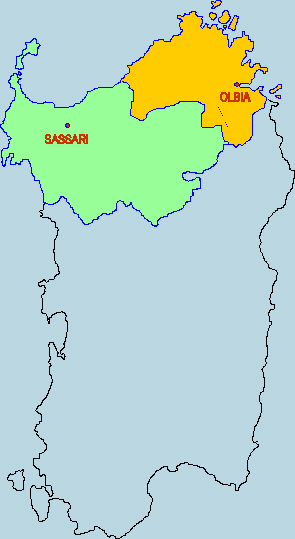

Sassari Cancer Registry
1992/94
|
|
|
Sassari Province
extends for 7,520 square kilometers: consequently, it is the widest among the ninety-five Italian Provinces before Bolzano (7,400 square kilometres), Foggia (7,185), Nuoro (7,044), Cuneo (6,903) and Cagliari (6,895). Its administration is divided into 89 towns and it has 454,904 inhabitants, as pointed out by the latest census; its population density is 60 people per square kilometer, less than a third with reference to the national average (190 people per square kilometer). In Sardinia, between 1988 and 1989, the composed average rate of population increase was 0.47%, more than twice the national one (0.21%) but lower than the one of Southern Italy (0.62%). Projections carried out in Sassari Province (23, 35) showed a constant population with reference to 1991 census data and anticipated a first but light downturn in the year 2000.In Sardinia, the number of born alive per 1,000 fertile-aged women fell from 58 in 1980 to 45 in 1985 and to 41 in 1987.
At the same time, these indicators were 65-55 and 52 in the Southern Italy and 48-42 and 39 in the country. The population migratory component showed a positive balance of the immigrants/emigrants ratio between 1982 and 1987; this positive balance set at zero in 1988 and turned negative in 1989. In the same year, the negative variation amounted to 439 people, whereas the last negative balance of the immigrants/emigrants ratio in the Sassari Province is dated 1970. Projections till the year 2000 show an immigration positive balance, which amounts to 2,000 people for every year.
In 1991, inhabitants at census were 453,556 according to temporary data. The increase as regards the previous census was very modest: 4.5% or, in absolute terms, 20,286 people. On the contrary, in 1981 - with reference to the previous decade - the increase amounted to 9% or to 35,951 people.
Population is irregularly placed over the territory: the main town (Sassari, provincial capital) has about 122,000 inhabitants; three towns (Alghero, Olbia, Porto Torres) have a number of inhabitants between 20,000 and 50,000; three towns (Tempio, Ozieri, Sorso) have little more than 10,000 inhabitants and the remainder of the population is divided into 83 scattered villages.
A more and more evident peculiarity in census is the population increase in the coastal towns (Olbia, Palau, Arzachena, Valledoria), whereas the inland towns are subject to a population decrease. On the contrary, Sassari and Porto Torres show a considerably population increase slackening, even if the movement is still positive.
SASSARI PROVINCE
|
Sassari province mean population |
||
|
(1992/94) |
||
|
Eta' |
Males |
Females |
|
0-4 |
11.662 |
11.062 |
|
5-9 |
13.273 |
12.392 |
|
10-14 |
15.446 |
14.443 |
|
15-19 |
19.287 |
18.279 |
|
20-24 |
20.297 |
19.713 |
|
25-29 |
19.844 |
19.875 |
|
30-34 |
18.504 |
18.483 |
|
35-39 |
17.055 |
16.604 |
|
40-44 |
15.961 |
15.675 |
|
45-49 |
14.799 |
14.673 |
|
50-54 |
13.634 |
14.225 |
|
55-59 |
12.008 |
12.806 |
|
60-64 |
11.063 |
12.192 |
|
65-69 |
9.335 |
10.918 |
|
70-74 |
6.755 |
8.709 |
|
75-80 |
4.713 |
6.272 |
|
>80 |
5.666 |
9.001 |
|
Totale |
229.301 |
235.321 |
|
|
|||
|
|
By Gianpaolo Mameli |